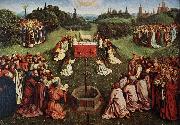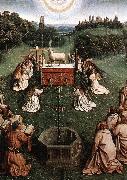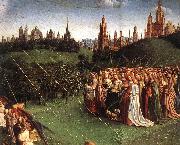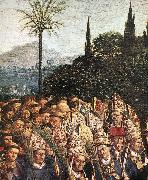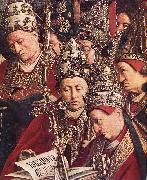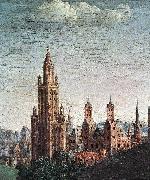Wholesale Oil Painting No Minimum |
|||||||||||
|
|
|||||||||||

|
|||||||||||
|
|
|
||||||||
EYCK, Jan vanFlemish Northern Renaissance Painter, ca.1395-1441 Painter and illuminator, brother of Hubert van Eyck. According to a 16th-century Ghent tradition, represented by van Vaernewijck and Lucas d'Heere, Jan trained with his brother Hubert. Pietro Summonte's assertion (1524) that he began work as an illuminator is supported by the fine technique and small scale of most of Jan's works, by manuscript precedents for certain of his motifs, and by his payment in 1439 for initials in a book (untraced) for Philip the Good, Duke of Burgundy. Jan is first documented in The Hague in August 1422 as an established artist with an assistant and the title of 'Master', working for John III, Count of Holland (John of Bavaria; reg 1419-25), who evidently discovered the artist while he was bishop (1389-1417) of the principality of Liege. |
||||||||
|
|
||||||||
Adoration of the Lamb (detail)
Adoration of the Lamb (detail) Painting ID:: 32307 |
1425-29
Oil on wood 1425-29 Oil on wood |
|||||||
|
|
||||||||
EYCK, Jan vanFlemish Northern Renaissance Painter, ca.1395-1441 Painter and illuminator, brother of Hubert van Eyck. According to a 16th-century Ghent tradition, represented by van Vaernewijck and Lucas d'Heere, Jan trained with his brother Hubert. Pietro Summonte's assertion (1524) that he began work as an illuminator is supported by the fine technique and small scale of most of Jan's works, by manuscript precedents for certain of his motifs, and by his payment in 1439 for initials in a book (untraced) for Philip the Good, Duke of Burgundy. Jan is first documented in The Hague in August 1422 as an established artist with an assistant and the title of 'Master', working for John III, Count of Holland (John of Bavaria; reg 1419-25), who evidently discovered the artist while he was bishop (1389-1417) of the principality of Liege. |
||||||||
|
|
||||||||
|
|
Adoration of the Lamb (detail)
Adoration of the Lamb (detail) Painting ID:: 32310 |
1425-29
Oil on wood 1425-29 Oil on wood |
||||||
|
|
||||||||
EYCK, Jan vanFlemish Northern Renaissance Painter, ca.1395-1441 Painter and illuminator, brother of Hubert van Eyck. According to a 16th-century Ghent tradition, represented by van Vaernewijck and Lucas d'Heere, Jan trained with his brother Hubert. Pietro Summonte's assertion (1524) that he began work as an illuminator is supported by the fine technique and small scale of most of Jan's works, by manuscript precedents for certain of his motifs, and by his payment in 1439 for initials in a book (untraced) for Philip the Good, Duke of Burgundy. Jan is first documented in The Hague in August 1422 as an established artist with an assistant and the title of 'Master', working for John III, Count of Holland (John of Bavaria; reg 1419-25), who evidently discovered the artist while he was bishop (1389-1417) of the principality of Liege. |
||||||||
|
|
||||||||
|
|
Adoration of the Lamb (detail)
Adoration of the Lamb (detail) Painting ID:: 32311 |
1425-29
Oil on wood,
height of detail: 26 cm 1425-29 Oil on wood, height of detail: 26 cm |
||||||
|
|
||||||||
EYCK, Jan vanFlemish Northern Renaissance Painter, ca.1395-1441 Painter and illuminator, brother of Hubert van Eyck. According to a 16th-century Ghent tradition, represented by van Vaernewijck and Lucas d'Heere, Jan trained with his brother Hubert. Pietro Summonte's assertion (1524) that he began work as an illuminator is supported by the fine technique and small scale of most of Jan's works, by manuscript precedents for certain of his motifs, and by his payment in 1439 for initials in a book (untraced) for Philip the Good, Duke of Burgundy. Jan is first documented in The Hague in August 1422 as an established artist with an assistant and the title of 'Master', working for John III, Count of Holland (John of Bavaria; reg 1419-25), who evidently discovered the artist while he was bishop (1389-1417) of the principality of Liege. |
||||||||
|
|
||||||||
|
|
Adoration of the Lamb (detail)
Adoration of the Lamb (detail) Painting ID:: 32312 |
1425-29
Oil on wood 1425-29 Oil on wood |
||||||
|
|
||||||||
EYCK, Jan vanFlemish Northern Renaissance Painter, ca.1395-1441 Painter and illuminator, brother of Hubert van Eyck. According to a 16th-century Ghent tradition, represented by van Vaernewijck and Lucas d'Heere, Jan trained with his brother Hubert. Pietro Summonte's assertion (1524) that he began work as an illuminator is supported by the fine technique and small scale of most of Jan's works, by manuscript precedents for certain of his motifs, and by his payment in 1439 for initials in a book (untraced) for Philip the Good, Duke of Burgundy. Jan is first documented in The Hague in August 1422 as an established artist with an assistant and the title of 'Master', working for John III, Count of Holland (John of Bavaria; reg 1419-25), who evidently discovered the artist while he was bishop (1389-1417) of the principality of Liege. |
||||||||
|
|
||||||||
|
|
Adoration of the Lamb (detail)
Adoration of the Lamb (detail) Painting ID:: 32313 |
1425-29
Oil on wood,
height of detail: 26 cm 1425-29 Oil on wood, height of detail: 26 cm |
||||||
|
|
||||||||
EYCK, Jan vanFlemish Northern Renaissance Painter, ca.1395-1441 Painter and illuminator, brother of Hubert van Eyck. According to a 16th-century Ghent tradition, represented by van Vaernewijck and Lucas d'Heere, Jan trained with his brother Hubert. Pietro Summonte's assertion (1524) that he began work as an illuminator is supported by the fine technique and small scale of most of Jan's works, by manuscript precedents for certain of his motifs, and by his payment in 1439 for initials in a book (untraced) for Philip the Good, Duke of Burgundy. Jan is first documented in The Hague in August 1422 as an established artist with an assistant and the title of 'Master', working for John III, Count of Holland (John of Bavaria; reg 1419-25), who evidently discovered the artist while he was bishop (1389-1417) of the principality of Liege. |
||||||||
|
|
||||||||
|
|
Adoration of the Lamb (detail)
Adoration of the Lamb (detail) Painting ID:: 32314 |
1425-29
Oil on wood, height of detail: 26 CM 1425-29 Oil on wood, height of detail: 26 CM |
||||||
|
|
||||||||
EYCK, Jan vanFlemish Northern Renaissance Painter, ca.1395-1441 Painter and illuminator, brother of Hubert van Eyck. According to a 16th-century Ghent tradition, represented by van Vaernewijck and Lucas d'Heere, Jan trained with his brother Hubert. Pietro Summonte's assertion (1524) that he began work as an illuminator is supported by the fine technique and small scale of most of Jan's works, by manuscript precedents for certain of his motifs, and by his payment in 1439 for initials in a book (untraced) for Philip the Good, Duke of Burgundy. Jan is first documented in The Hague in August 1422 as an established artist with an assistant and the title of 'Master', working for John III, Count of Holland (John of Bavaria; reg 1419-25), who evidently discovered the artist while he was bishop (1389-1417) of the principality of Liege. |
||||||||
|
|
||||||||
|
|
Adoration of the Lamb (detail)
Adoration of the Lamb (detail) Painting ID:: 32315 |
1425-29
Oil on wood, height of detail: 26 cm 1425-29 Oil on wood, height of detail: 26 cm |
||||||
|
|
||||||||
EYCK, Jan vanFlemish Northern Renaissance Painter, ca.1395-1441 Painter and illuminator, brother of Hubert van Eyck. According to a 16th-century Ghent tradition, represented by van Vaernewijck and Lucas d'Heere, Jan trained with his brother Hubert. Pietro Summonte's assertion (1524) that he began work as an illuminator is supported by the fine technique and small scale of most of Jan's works, by manuscript precedents for certain of his motifs, and by his payment in 1439 for initials in a book (untraced) for Philip the Good, Duke of Burgundy. Jan is first documented in The Hague in August 1422 as an established artist with an assistant and the title of 'Master', working for John III, Count of Holland (John of Bavaria; reg 1419-25), who evidently discovered the artist while he was bishop (1389-1417) of the principality of Liege. |
||||||||
|
|
||||||||
|
|
Adoration of the Lamb (detail)
Adoration of the Lamb (detail) Painting ID:: 32316 |
1425-29
Oil on wood, height of detail: 26 cm 1425-29 Oil on wood, height of detail: 26 cm |
||||||
|
|
||||||||
|
EYCK, Jan van Flemish Northern Renaissance Painter, ca.1395-1441 Painter and illuminator, brother of Hubert van Eyck. According to a 16th-century Ghent tradition, represented by van Vaernewijck and Lucas d'Heere, Jan trained with his brother Hubert. Pietro Summonte's assertion (1524) that he began work as an illuminator is supported by the fine technique and small scale of most of Jan's works, by manuscript precedents for certain of his motifs, and by his payment in 1439 for initials in a book (untraced) for Philip the Good, Duke of Burgundy. Jan is first documented in The Hague in August 1422 as an established artist with an assistant and the title of 'Master', working for John III, Count of Holland (John of Bavaria; reg 1419-25), who evidently discovered the artist while he was bishop (1389-1417) of the principality of Liege. Adoration of the Lamb (detail) 1425-29 Oil on wood, height of detail: 26 cm |
||||||||
|
|
||||||||
|
Prev Next
|
||||||||
|
|
||||||||
|
Related Paintings to EYCK, Jan van :. |
||||||||
|
|
||||||||
|
CONTACT US |
